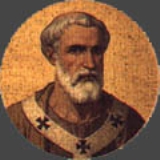
Pope Leo VII
Encyclopedia
Pope Leo VII Pope
from January 3, 936 until his death in 939, was preceded by Pope John XI
(931–935), and followed by Pope Stephen VIII
(939–942). Leo VII's election to the papacy was secured by Alberic II of Spoleto
, the monarch in Rome
. Alberic wanted to choose the pope so that the papacy would continue to yield to his authority. Leo was the priest of St. Sixtus in Rome, thought to be a Benedictine
monk. He had little ambition towards the papacy, but consented under pressure.
As pope, Leo VII reigned for only three years. Most of his bulls
were grants of privilege to monasteries, especially including the Abbey of Cluny. Leo called for Odo of Cluny
to mediate between Alberic and Hugh of Italy
, Alberic's stepfather, the King of Italy
. Odo was successful in negotiating a truce after arranging a marriage between Hugh's daughter Alda and Alberic. Leo VII also appointed Frederick, Archbishop of Mainz
as a reformer in Germany. Leo allowed Frederick to drive out Jews
that refused to be baptized, but he did not endorse the forced baptism of Jews.
After his death in July of 939, Leo VII was interred at St. Peter's Basilica
.
Pope
The Pope is the Bishop of Rome, a position that makes him the leader of the worldwide Catholic Church . In the Catholic Church, the Pope is regarded as the successor of Saint Peter, the Apostle...
from January 3, 936 until his death in 939, was preceded by Pope John XI
Pope John XI
Pope John XI was a Pope from March 931 to December 935.-Parentage:The parentage of John XI is still a matter of dispute. According to Liutprand of Cremona and the "Liber Pontificalis," he was the natural son of Pope Sergius III , Pope John XI (910? – December 935) was a Pope from March 931 (at...
(931–935), and followed by Pope Stephen VIII
Pope Stephen VIII
Pope Stephen VIII, a native of Germany, was pope from about July 14, 939 until his death towards the end of October 942.During his pontificate he was subject to Alberic II of Spoleto, Prince of the Romans, and did not effectively rule the Papal States...
(939–942). Leo VII's election to the papacy was secured by Alberic II of Spoleto
Alberic II of Spoleto
Alberic II was ruler of Rome from 932 to 954, after deposing his mother Marozia and his stepfather, King Hugh of Italy.He was of the house of the Counts of Tusculum, the son of the notorious Marozia by her first husband, Alberic I, Duke of Spoleto. His half-brother was Pope John XI...
, the monarch in Rome
Rome
Rome is the capital of Italy and the country's largest and most populated city and comune, with over 2.7 million residents in . The city is located in the central-western portion of the Italian Peninsula, on the Tiber River within the Lazio region of Italy.Rome's history spans two and a half...
. Alberic wanted to choose the pope so that the papacy would continue to yield to his authority. Leo was the priest of St. Sixtus in Rome, thought to be a Benedictine
Benedictine
Benedictine refers to the spirituality and consecrated life in accordance with the Rule of St Benedict, written by Benedict of Nursia in the sixth century for the cenobitic communities he founded in central Italy. The most notable of these is Monte Cassino, the first monastery founded by Benedict...
monk. He had little ambition towards the papacy, but consented under pressure.
As pope, Leo VII reigned for only three years. Most of his bulls
Papal bull
A Papal bull is a particular type of letters patent or charter issued by a Pope of the Catholic Church. It is named after the bulla that was appended to the end in order to authenticate it....
were grants of privilege to monasteries, especially including the Abbey of Cluny. Leo called for Odo of Cluny
Odo of Cluny
Saint Odo of Cluny , a saint of the Roman Catholic Church, was the second abbot of Cluny. He enacted various reforms in the Cluniac monastery system of France and Italy....
to mediate between Alberic and Hugh of Italy
Hugh of Italy
Hugh of Arles was King of Italy from 924 until his death. He was a Bosonid. During his reign, he empowered his relatives at the expense of the aristocracy and tried to establish a relationship with the Byzantine-Roman Empire...
, Alberic's stepfather, the King of Italy
King of Italy
King of Italy is a title adopted by many rulers of the Italian peninsula after the fall of the Roman Empire...
. Odo was successful in negotiating a truce after arranging a marriage between Hugh's daughter Alda and Alberic. Leo VII also appointed Frederick, Archbishop of Mainz
Frederick, Archbishop of Mainz
Frederick was the Archbishop of Mainz from 937, following the late Hildebert, until his death. He was a son of Reginar, Duke of Lorraine....
as a reformer in Germany. Leo allowed Frederick to drive out Jews
Jews
The Jews , also known as the Jewish people, are a nation and ethnoreligious group originating in the Israelites or Hebrews of the Ancient Near East. The Jewish ethnicity, nationality, and religion are strongly interrelated, as Judaism is the traditional faith of the Jewish nation...
that refused to be baptized, but he did not endorse the forced baptism of Jews.
After his death in July of 939, Leo VII was interred at St. Peter's Basilica
St. Peter's Basilica
The Papal Basilica of Saint Peter , officially known in Italian as ' and commonly known as Saint Peter's Basilica, is a Late Renaissance church located within the Vatican City. Saint Peter's Basilica has the largest interior of any Christian church in the world...
.

